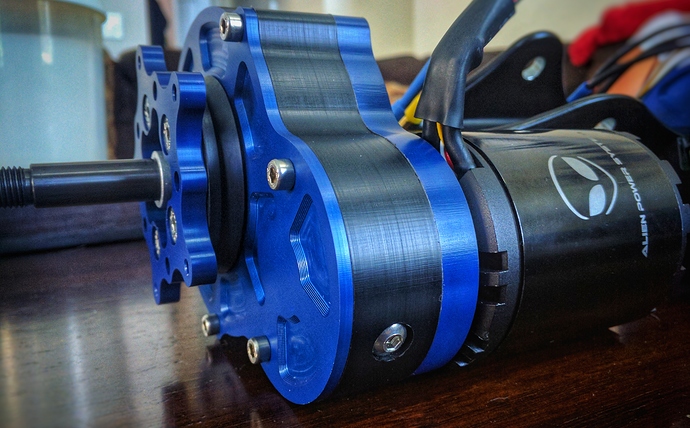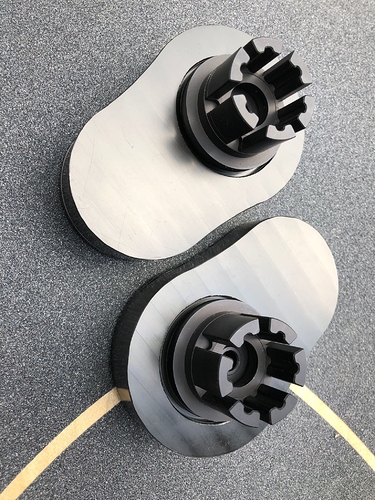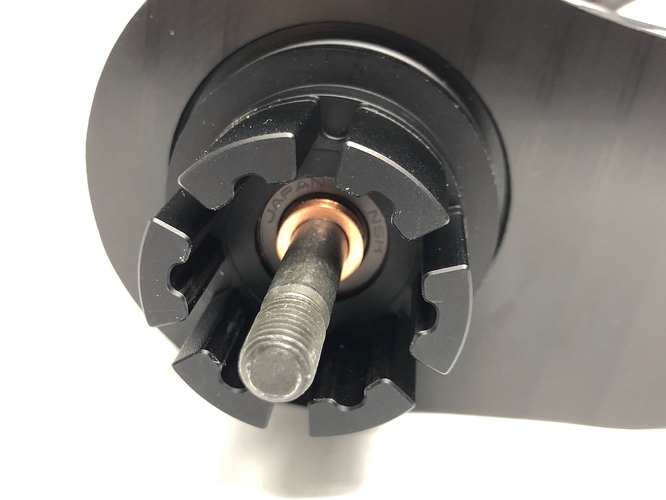So for the most part, I have only seen belts and inwheel motors. Why doesn’t anyone use gears instead? Wouldn’t this decrease slippage that a belt normally experiences?
There are a bunch of people that use chain drive setups, but a properly setup belt drive system won’t slip anyway. Idlers and/or bigger pulleys help with this.
I don’t use chain mainly due to the availability of pulleys and the low cost of belts. I prefer it anyway since they’re a quieter solution.
“That a belt normally experiences” true, slippage can occur, but it normally doesn’t just slip/skip unless there is something wrong. The same thing can happen with a direct gear set up if something is wrong, it can skip as well.
There are a few boards in prototype with direct gear set ups:
I plan to use chain. I’m machining my own sprockets for fun and to save a few bucks. Chains are super inexpensive (I got 3 feet for $10 shipped) so don’t let cost sway you one way or the other. Belts are definitely going to be the quieter and sleeker option. Direct drive is super cool but I hope you know you would likely never see a 1 to 1 setup like you picture posted above on an electric longboard.
Any type of transmission system you choose will have design constraints & they always introduce losses from friction & require maintenance.
We have spent the last 12 months+ researching this topic and there is only one viable answer. Direct Drive.
What research exactly lead you to this?
It’s all about what you are willing to give up. While direct drive has no losses in the mechanical system. You are increasing losses in the electrical system.
A gear, or any type of reduction system will produce less heat than the equivalent direct drive system. This also means more current and battery wasted.
So sure if your goal is to produce a mechanical system with the least amount of friction, direct drive will be your bet. But that doesn’t mean it is the most efficient, powerful, easily serviceable. Etc.
Direct drive could win for top speed, if in numbers. But anything shy of an AWD and I doubt a hub or direct drive could keep up with a reduction drive.
Anyway you are gonna have lots of different thoughts on this here… But the answer really comes down to “what do you want from your board?”
The watt hour per mile values are insane. Almost 30% less than belt drive. It’s louder, but that doesn’t bother me.
I would encourage you to use keys, the increase in torque, at least on my build, is more than grub screws and loktite can handle. I’m getting new motor spur gears and and gonna cut key slots in them.
What do you mean a gear? a gear system WOULD be a direct drive system, and I’m not sure how it would cause more current or battery wasted
Same question, why would you be getting less out of you batteries?
Yea in any gearbox you want to put a key on your motor, and dont use circular shafts but instead opt for hex shafts. That doesn’t matter for belt drive systems though because the first thing to fail there will always be the belt
Direct drives are not gear drives. I know a few are named like that. But direct drive is 1:1 no reduction with the motor directly driving the wheel(is Carvons, flies direct drive, torqueboards soon to be DD)
![]()
Ps I know I called Jenso’s Direct Drives on my trampa thread… because that’s what they are “named” not necessarily what they are.
Confusing…I know lol
You are right, my bad lmao all these terms are getting hard to remember. Frankly I think that Direct Drive systems are unnecessary and force you to get a bigger and more inconvenient motor, I’m personally going to try a gear down so that I won’t have to worry about skipping belts and destroying the belts teeth, and the noisy and tedious to tension chains. I dont see any benefit to not gearing down a motor, no matter how you are delivering power to the wheels.
Wouldn’t direct drives be more efficient because there is no loss of energy that would otherwise occur in belt or gear driven are drives? What does @professor_shartsis calculations say about this, lol.
Did you make that gearbox? If you did can you upload a step file of it bc I’m curious how it comes together. Also to answer @Naysh the efficiency of a gear system will stay the same no matter how you change it the gear ratios (as long as you do not add any extra gear phases). And back to you Deck you said that as if i was arguing those weren’t gearbox drives, but those pictures weren’t even on this topic
Oh no I didn’t mean anything by it. Was just posting some of the ones available. @Nowind and @Kug3lis make them for sale.
No worries lol, I’ll message them tmrow to see if they are will to show me some cad 
That’s not true. Unloaded it can be true. But add load and your watthour/mile will be drastically different with different reductions.
if a controller has no erpm limit, then for a given stator & copper volume, the higher kv motor can produce more mechanical power for the same losses, making it more efficient.
by adjusting the gear reduction ratio, you can select the ground speed at which the motor produces peak mechanical power, and generally increasing the gear reduction ratio improves efficiency.
the high rpms at which a high kv motor outputs its peak power might not be suitable for a direct drive / hub motor without some gear reduction.





